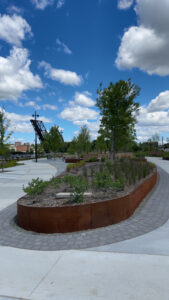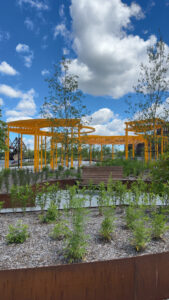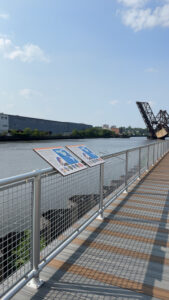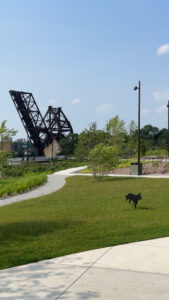
A once off-limits space along the Passaic River is now a five-acre park. (Photo by Spencer Brilhante)
This story was produced in collaboration with CivicStory as part of the NJ Ecology-Civics Reporting Project.
On a sunny morning, Maria Cruz sits on a bench with her niece, taking in the fresh air and enjoying the warm weather along the Passaic River waterfront.
“I walk past this area a lot, and it was a dead zone for the longest time,” said the 53-year-old nurse practitioner, a longtime Borough of East Newark resident. “It’s nice that there is finally a place where people in the area can just relax without having to drive somewhere.”
Opened on May 9, East Newark’s new Riverfront Park is a vibrant five-acre public space along the Passaic River that was an industrial site just a few years ago. It features a 1,000-foot boardwalk, an amphitheater, and areas for picnicking and play.

The former industrial site was turned into a park, following a settlement between the Department of Justice and over 80 companies. (Photo by Spencer Brilhante)
As local residents explore the park’s paths and river views, some visitors see how this area’s transformation shows that once-contaminated land can become much-needed public space.
“This land had been vacant for so long,” said 34-year-old local resident Joseph Estevez. “Having it become something clean and pleasant for the people to utilize was the best thing that could’ve happened, and it couldn’t have come at a better time—especially with summer just upon us.”

Portions of the Passaic River have been deemed a Superfund site after decades of toxic dumping. (Photo by Spencer Brilhante)
The Passaic River, which runs roughly 80 miles through the northern part of New Jersey, had been an important waterway for the region’s Indigenous communities prior to European colonization and later played a key role throughout the Industrial Revolution. Throughout the 20th century, manufacturers operated facilities along the river, especially in and around Newark—a legacy that underscores how the Passaic became one of the most polluted bodies of water in the United States.
For decades, companies evaded responsibility for dumping toxins into the river, most infamously the defoliant Agent Orange, which was manufactured at the former Diamond Alkali plant in Newark. In recent years, however, impacted communities have successfully pressured authorities to hold these alleged polluters accountable for the conditions they left behind.
As part of a 2022 settlement with the U.S. Justice Department and Environmental Protection Agency, over 80 companies connected to pollution in the lower Passaic River agreed to pay $150 million to support cleanup initiatives.
Advocates say the settlement was long overdue, and the waterfront park reflects the needs of residents who live along the Passaic.
“The community organized and advocated for more green space, which led to the creation of the park,” said Chloe Desir, a spokesperson from the Ironbound Community Corporation. “When it came to who would be financially responsible for the clean-up, it took a lot of back and forth between responsible companies on what amount would be paid.”
BASF Corporation, one of the firms the DOJ says bears responsibility for the hazardous conditions at the Diamond Alkali site, offered to transform the waterfront property into a park in exchange for millions of dollars in credits that could be applied to other restoration efforts. The company has not disclosed the project’s total cost.
Step in the Right Direction

The East Newark Riverfront Park opened on May 9.
(Photo by Spencer Brilhante)
Some observers hope that this example of corporate and public collaboration to address a longstanding environmental hazard can be a model for future restorations in and around Newark.
“We need all the park space along the river we can get. Hopefully, we’ll eventually have a park along the entire river,” said Nancy Zak, an associate from the Ironbound Community Corporation.
While the new park brings a refreshing change, some feel it highlights how the riverfront has been neglected over the years. There is hope that this signals more consistent attention to the long-overlooked parts of the city.
“The new park is a great addition to the area, and I’m grateful that BASF helped fund it,” said 29-year-old local resident Nicole Vega. “However, I think there’s a lot more that the city can still do to improve the area.”
“This is a good step in the right direction, and I’m really looking forward to seeing what other renovations the city has in store for the future.”
This story was produced in collaboration with CivicStory as part of the NJ Ecology-Civics Reporting Project..

Spencer Brilhante is a 2025 CivicStory Ecology-Civics fellow and a student journalist attending Rutgers University-Newark.
